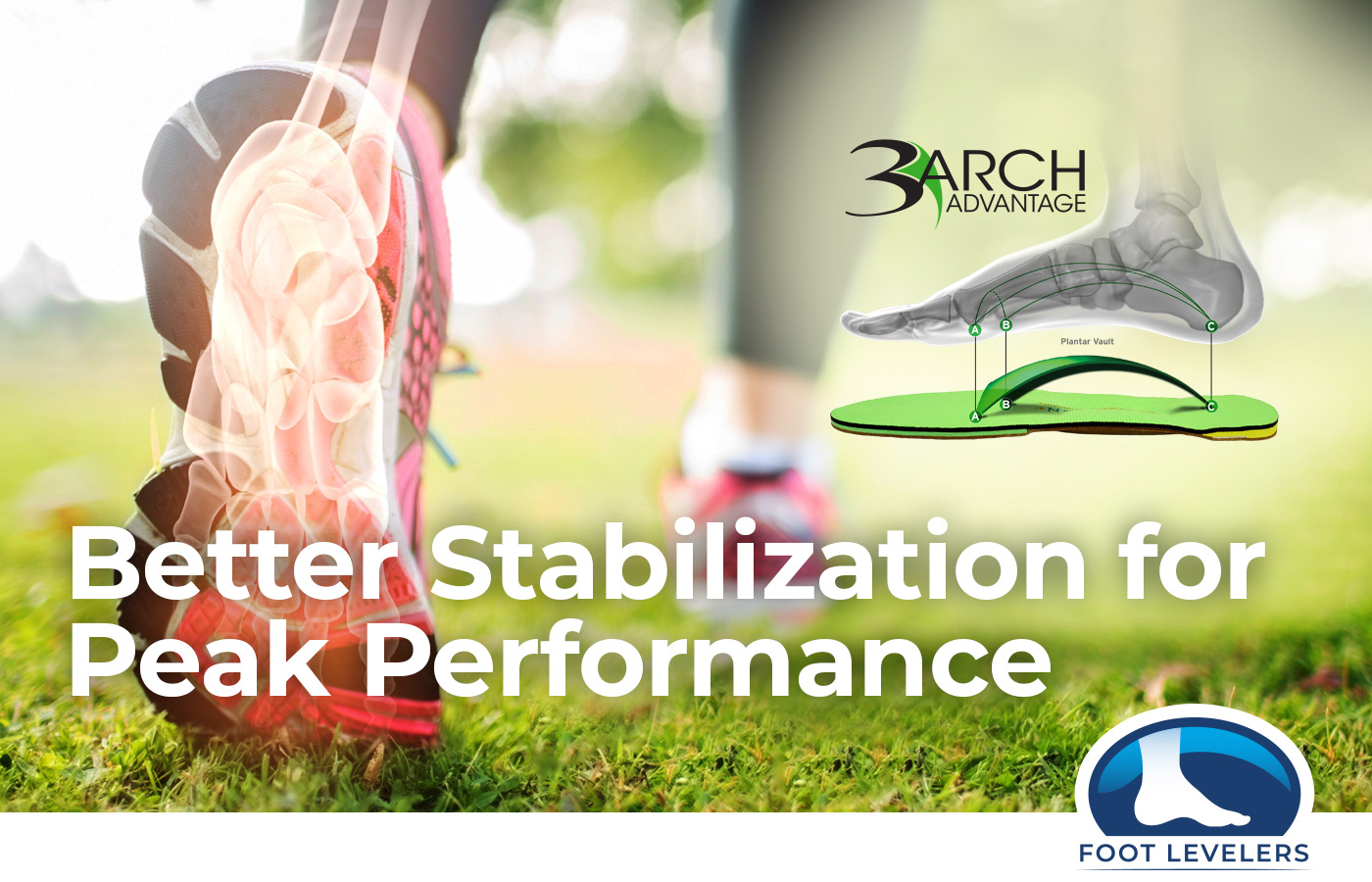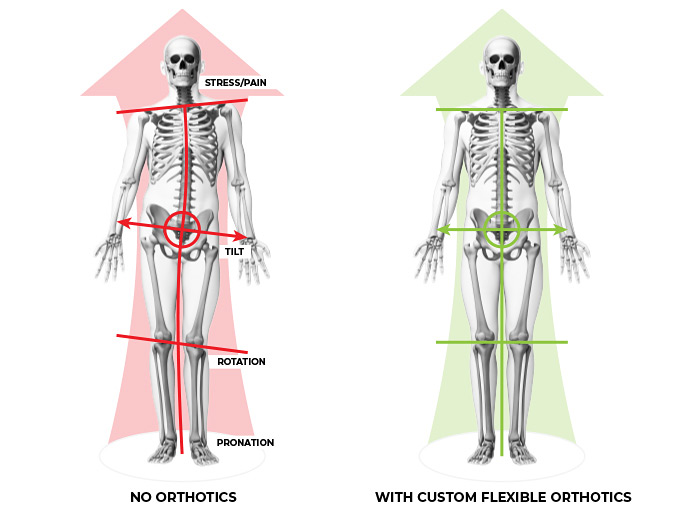Boost Your Patients' Game with the Right Support
Proper stabilization with 3-arch support is proven to help improve performance and reduce pain*

Throughout the summer, many patients use the longer, sunnier days to spend more time outdoors playing sports and being more active. This can add up to increased strain on their bodies that can impact performance.
Chiropractors can partner with their patients to help them move ergonomically, to realize their fullest athletic potential and lower the risk of injuries that could send them to the sidelines. You can assess their foot function and restore healthy balance and alignment of the entire body with custom flexible orthotics that support all three arches of the foot. This contributes to adjustments that hold better and enhances the success of ongoing chiropractic care.
Peak Performance Begins with Better Ergonomics
Most people are not attuned to proper ergonomics and body position when they play sports. Even when they have coaches or personal trainers, many athletes are uninformed about how poor body mechanics can contribute to pain and impede performance. They could be standing, lifting, bending, or moving improperly and when those motions are repeated over and over, it increases the stress throughout the kinetic chain. As an expert on how all parts of the body are interconnected, you can use your knowledge of posture and biomechanics to help them understand how this affects the sports they love.
You don’t need to be an expert in the particulars of every sport to advise patients on the proper mechanics of healthy movement. It can be as easy as having the patient demonstrate how they swing their tennis racquet or golf club, dribble a basketball or jump up to spike a volleyball. Observe them as they perform their activity and you can identify aspects of their movements that exhibit stress on their body parts.
These can then be corrected so their mechanics are more ergonomic. Even small changes can make a big difference in their endurance, speed, strength and range of motion. Whether they are serious athletes or just trying to be more active for better health, your guidance can help them reach their highest potential.
Let’s address some of the most popular summer sports:
Golf, Baseball, and Softball:
Neck, shoulder, elbow and wrist/hand injuries are common due to the repetitive nature of stress from swinging the club or bat in a unilateral fashion. These athletes tend to swing to the same side all of the time when hitting a golf ball, baseball, or softball. There is very little contralateral balance, or swinging to the other side, to keep the body even. The frequent twisting of the torso and pelvis can cause spinal and rib pain as well. Baseball and softball also include the element of running. That will create issues in the lower extremities as well.
Running
Overuse injuries are common in running, and up to 79% of runners may be injured in a given year.** Plantar fasciitis, patellofemoral pain syndrome (PFPS), Achilles tendonitis and iliotibial band (ITB) syndrome are conditions commonly associated with running. While the repetitive motions of running impact the entire body, knees especially bear the brunt of the excessive force generated. When a person runs, their knees experience pressure equal to approximately five times their body’s weight with every stride. It’s crucial that their bodies are correctly aligned and that they observe proper form to mitigate further joint stress and run more efficiently.
Basketball and Volleyball
In basketball, jogging and running are coupled with the usage of the upper extremities. These can cause issues all over the body from the feet/ankles upwards. Volleyball and basketball incorporate jumping motions and the shock of jumping and landing on the feet magnifies the ground shock that begins at the feet/ankles and moves up into the knees, hips, pelvis, spine, neck, shoulder, elbows and wrists/hands.
Tennis and Pickleball:
Racket sports are notorious for contributing to shoulder, neck, and upper back pain. When you couple that with all of the twisting of the torso and lower back, you can get spinal pain and rib subluxations in the front, back, or side of the chest. In tennis, a lot of power is generated through the upper extremity which then transfers from the racket head to the ball. This puts repetitive stress on all of the upper extremities. Add in the short bursts of sprinting, lunging, and jumping, and there could be lower extremity strain as well.
Pickleball is a faster-paced game on a smaller court. The plastic ball is lighter than a tennis ball and players usually play doubles. Depending on position, a player may not be required to move their feet as much as in tennis. Pickleball players experience many of the same issues as tennis players and have an increased rate of injuries due to how much faster the game is and the increased frequency of the lunging and reaching for the pickleball.
Hiking:
With hiking in full swing, have your patient bring in their fully weighted daypack or backpack for you to examine. Keep these parameters in mind:
A loaded daypack should not weigh more than about 10 percent of the person’s body weight (if a patient weighs 150 pounds, their daypack should not exceed 15 pounds).
A loaded backpack should not weigh more than about 20 percent of a person’s body weight (if a patient weighs 150 pounds, their backpack should not exceed 30 pounds).
People typically do not wear their packs properly. Often the pack is resting too low on the body somewhere near the patient’s lower back or pelvis instead of around the upper/mid back. Have them put the pack on in front of you so you can adjust it for them. It’s crucial that they use a pack that is suitable for their body and frame shape.
Another key factor: the weight of the pack also puts extra pressure on the patient’s feet. This further exacerbates overpronation or oversupination of the feet. Custom orthotics with proper three arch support are especially critical for these patients. Uneven trail terrain also calls for the enhanced stability orthotics provide; this can help boost endurance and reduce injuries.
Cycling:
On a traditional, upright bicycle, a biker is sitting in their seat and their sacrum and SI joints are under pressure. They also lean forward while riding to create a more streamlined silhouette on the bike to reduce wind resistance for greater speed. Occasional bumps, potholes, curbs and other road hazards can increase the stress on their bodies.
Have the patient bring in their bike and help them adjust the seats and handlebars for the optimal ergonomic position. You can analyze how much stress their spine and extremities are experiencing when you watch them ride or simulate their ride. You could also demonstrate proper riding positions to help them understand. Partnering with local biking groups to provide this service to their members is a great way to expand your chiropractic expertise to athletes within your community and help you heal more patients.
Don’t Forget About the Feet
In any weightbearing activity, the negative biomechanics of excessive foot pronation will affect the lower extremity, the axial spine, and the upper extremity. Under optimal circumstances, the 3 plantar foot arches function to absorb and disperse the 5 G of ground shock on an average heel strike. Healthy functioning arches dampen the shockwave to 0.5 G by the time it reaches the head and jaw.
If the foot is excessively pronating, the arches are flatter, and the heel strike shockwave comes into the body with more and more force. Thus the biomechanical stress on the joints and soft tissues is also increased and the repetitive activities and sports can cause pain that they present to our clinics. Keeping the 26 foot bones adjusted and the three arches properly supported is key to the longer-term stability of the whole body no matter what sport they are engaged in.
Treatment Suggestions:
- Provide a plan for ongoing, proactive chiropractic care. Regular chiropractic adjustments to the spine and extremities will address postural instability for better performance while reducing joint and soft tissue impact, helping to break the cycle of chronic pain and injuries. Chiropractic care helps patients achieve optimal form and posture for better performance in all sports.
- Assess every patient’s feet—practically everyone has some degree of foot dysfunction and would benefit from custom flexible orthotics that support all three arches of the feet to help reduce pain, fight fatigue and lessen joint stress. This ensures the feet are supporting the axial kinetic chain. Support from the ground up will help reduce shock and stress and stabilize the spine and extremities. Patients should wear their orthotics not just during sports but in all their daily activities. This helps maintain healthy alignment for the best possible care.
The Importance of Foot Levelers 3-Arch Advantage®
Foot Levelers custom orthotics are the only orthotics that support all three arches of the foot, for total body alignment. Supporting just one or two of the arches doesn’t level the body’s foundation, the feet. This can lead to excessive stress throughout the kinetic chain, resulting in pain and a greater risk for injury. It can contribute to issues like plantar fasciitis and metatarsalgia.

Custom Correction for Optimal Outcomes
Each person’s foot structure is unique, like a fingerprint. The correction needed for the left foot may not be the same as what’s necessary for the right. Every pair of Foot Levelers custom flexible orthotics is individually made for each patient, for the best possible results.
Just as your patient wouldn’t get the best results from another person’s eyeglass prescription, they need custom stabilization that reflects their unique body needs for optimal health.
The Right Custom Orthotic for Every Activity—Optimal Movement, Driven by Science.
Foot Levelers uses proven science and over 70 years of chiropractic innovation to develop custom orthotics with durable, high-tech materials that stand up to everyday use and demanding play. Foot Levelers offers a wide range of custom orthotics and Shoethotics® orthotic footwear with features that complement the specific demands of various sports as well as everyday activities.
Explore Foot Levelers custom orthotics
Explore Foot Levelers Shoethotics® orthotic footwear
In Conclusion
Chiropractors can help each patient enjoy their favorite sports and achieve their personal best by reducing excessive strain on the body through ongoing care, ergonomic guidance, and custom three-arch orthotics. By implementing some of the tips in this blog into your care, you could become the go-to training partner for active people within your community during the summer season and all year round.
Grow your practice with Foot Levelers custom stabilization solutions.
Become a Foot Levelers Partner
* Cambron JA, Dexheimer JM, Duarte M, Freels S. Shoe Orthotics for the Treatment of Chronic Low Back Pain: A Randomized Controlled Trial. Arch Phys Med Rehabil. 2017 Sep;98(9):1752-1762. doi: 10.1016/j.apmr.2017.03.028. Epub 2017 Apr 30. PMID: 28465224.
**Bowser BJ, Fellin R, Milner CE, Pohl MB, Davis IS. Reducing Impact Loading in Runners: A One-Year Follow-up. Med Sci Sports Exerc. 2018 Dec;50(12):2500-2506. doi: 10.1249/MSS.0000000000001710. PMID: 29975300; PMCID: PMC6237638.